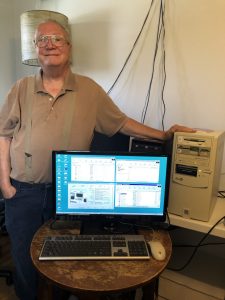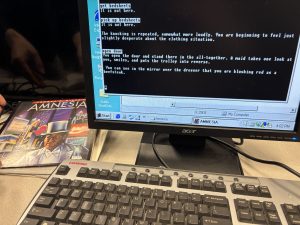 Last week I received two boxes containing a PC replete with the much and long desired 5.25-inch floppy disk drive (PleXWriter 12/10/32A), a legacy Windows keyboard and mouse, and Viewsonic LED monitor––all in perfect working order from Layne Wright in Colorado. He had read the article in the BBC News that I was looking for this particular computer system and began a series of conversation with me over email and the phone about my lab’s need. I asked him to share his background with our readers, which he sent me tonight:
Last week I received two boxes containing a PC replete with the much and long desired 5.25-inch floppy disk drive (PleXWriter 12/10/32A), a legacy Windows keyboard and mouse, and Viewsonic LED monitor––all in perfect working order from Layne Wright in Colorado. He had read the article in the BBC News that I was looking for this particular computer system and began a series of conversation with me over email and the phone about my lab’s need. I asked him to share his background with our readers, which he sent me tonight:
“Layne Wright holds degrees in Electrical Engineering (BSEE 78) and Physics (BA Phys 93), both from the University of Colorado, Boulder.” Regarding his career, he says, “Most of my engineering career involved writing mixed assembly and ‘C’ code for a variety of embedded microprocessor systems. After completing my Physics degree, my focus shifted to working out the mathematics for numerical algorithms used in both embedded and personal computers.”
As he told me, his interest in computers started in high-school, where he learned BASIC programming on a
time-shared computer accessed via teletype. As programs were saved on paper tape, editing was very tedious.
He writes that:
“[e]arly on in engineering school, my fellow colleagues and I learned about the Intel 4004, the 1st commercial microprocessor (uP). We were amazed a single chip could do so much, and we all dreamed of someday having our own personal computer.
Some years later, one of us managed to purchase an Altair 8800 (Intel 8080 based) for the princely sum of $1200 ($7000 in 2025). Using a borrowed teletype, our colleague demonstrated ‘Altair BASIC’, Microsoft’s founding product. I knew then that someday I WOULD own a personal computer.
I did purchase my first personal computer about (4) years after completing my EE degree; it was a Franklin Ace 1000, an Apple II clone. Some of my best work was written on that machine.”
 Once we booted up the computer on Friday, we found that we could access the IBM version of Thomas Disch’s 1986 game, Amnesia, published by EA, which we had never been able to experience before. This coming week we will host the naming ceremony of the computer as we do all of our legacy machines in the lab. In the past we have followed a convention whereby all computers were named for Star Wars characters. This time, we will name this one “Layne” in his honor.
Once we booted up the computer on Friday, we found that we could access the IBM version of Thomas Disch’s 1986 game, Amnesia, published by EA, which we had never been able to experience before. This coming week we will host the naming ceremony of the computer as we do all of our legacy machines in the lab. In the past we have followed a convention whereby all computers were named for Star Wars characters. This time, we will name this one “Layne” in his honor.
We are grateful for the support of people interested in Retro Computing.
